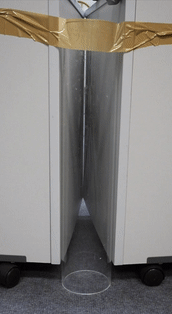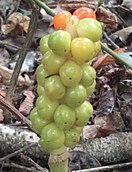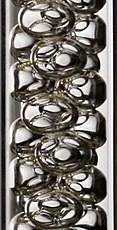User:JWinman/sandbox

Columnar structures are cylindrical arrangements that form in the context of sphere packings inside or on the surface of a columnar confinements. Spheres of identical size assemble on the surface of a cylinder to an ordered columnar structures, if the cylinder diameter is of similar order of magnitude.
A typical ordered columnar structure assembles by sequentially dropping golf balls inside a tube.
Appearance in science[edit]
Columnar structures appear in various research fields on a broad range of length scales from metres down to the nanoscale. On the largest scale, such structures can be found in botany where seeds of a plant assemble around the stem. On a smaller scale bubbles of equal size crystallise to columnar foam structures when confined in a glass tube. In nanoscience such structures can be found in man-made objects which are on length scales from a micron to the nanoscale.

Botany[edit]
Columnar structures were first studied in botany due to their divers appearances in plants.[1] D'Arcy Thompson analysed such arrangement of plant parts around the stem in his book "On Growth and Form" (1917). But they are also of interest in other biological areas, including bacteria[2], viruses[3], microtubules[4], as well as the notochord of the zebra fish[5].
One of the largest flowers where the berries arrange in a regular cylindrical form is the titan arum, also called corpse flower due to its rotten smell. This flower can be up to in height and is natively solely found in western Sumatra and western Java.
On smaller length scales, the berries of the arum maculatum form a columnar structure in autumn. Its berries are similar to that of the corpse flower, since it is its larger relative. However, the cuckoo-pint is much smaller in height (). The berry arrangement varies with the stem to berry size.
Another plant that can be found in many gardens of residential areas is the Australian bottlebrush. It assembles its seed capsules around a branch of the plant. The structure depends on the seed capsule size to branch size.
Foams[edit]

A further occurrence of ordered columnar arrangement on the macroscale are foam structures confined inside a glass tube. They can be realised experimentally with equal-sized soap bubbles inside a glass tube, produced by blowing air of constant gas flow through a needle dipped in a surfactant solution.[6] By putting the resulting foam column under forced drainage (feeding it with surfactant solution from the top), the foam can be adjusted to either a dry (bubbles shaped as polyhedrons) or wet (spherical bubbles) structure.[7]
Due to this simple experimental set-up, many columnar structures have been discovered and investigated in the context of foams with experiments as well as simulation. Lots of simulations have been carried out using the Surface Evolver to investigate dry structure or the hard sphere model for the wet limit where the bubbles are spherical.
In the zigzag structure the bubbles are stacked on top of each other in a continuous w-shape. For this particular structure a moving interface with increasing liquid fraction was reported by Hutzler et al. in 1997.[8] This included an unexpected 180° twist interface, whose explanation is still lacking.
The first experimental observation of a line-slip structure was discovered by Winkelmann et al. in a system of bubbles.[9]
Further discovered structures include complex structures with internal spheres/foam cells. Some dry foam structures with interior cells were found to consist of a chain of pentagonal dodecahedra or Kelvin cells in the centre of the tube.[10] For many more arrangements of this type, it was observed that the outside bubble layer is ordered, with each internal layer resembling a different, simpler columnar structure by using X-ray tomography.[6]
Nanoscience[edit]
Columnar structures have also been studied intensively in the context of nanotubes. Their physical or chemical properties can be altered by trapping identical particles inside them.[11][12][13] These are usually done by self-assembling fullerenes such as C60, C70, or C78 into carbon nanotubes[11], but also boron nitride nanotubes[14].
Such structures also assemble when particles are coated on the surface of a spherocylinder as in the context of pharmaceutical research. Lazáro et al. examined the morphologies of virus capsid proteins self-assembled around metal nanorods[15]. Drug particles were coated as densely as possible on a spherocylinder to provide the best medical treatment.
Wu et al. built rods of the size of several microns. These microrods are created by densely packing silica colloidal particles inside cylindrical pores. By solidifying the assembled structures the microrods were imaged and examined using scanning electron microscopy (SEM).[16]
Columnar arrangements are also investigates as a possible candidate of optical metamaterials (i.e. materials with a negative refractive index) which find applications in super lenses[17] or optical cloaking[18]. Tanjeem et al. are trying to construct such a resonator by self-assembling nanospheres on the surface of the cylinder.[19][20] The nanospheres are suspended in an SDS solution together with a cylinder of diameter , much larger than the diameter of the nanospheres (). The nanospheres stick to the surface of the cylinders by a depletion force.
Classification using phyllotactic notation[edit]
The most common way of classifying ordered columnar structures uses the phyllotactic notation, adopted from botany. It is used to describe arrangements of leaves of a plant, pine cones, or pineapples, but also planar patterns of florets in a sunflower head. While the arrangement in the former are cylindrical, the spirals in the latter are arranged on a disk. For columnar structures phyllotaxis in the context of cylindrical structures is adopted.
The phyllotactic notation describe such structures by a triplet of positive integers with . Each number , , and describes a family of spirals in the 3-dimensional packing. They count the number of spirals in each direction until the spiral repeats. This notation, however, only applies to triangular lattices and is therefore restricted to the ordered structures without internal spheres.
Types of ordered columnar structures without internal spheres[edit]
Ordered columnar structures without internal spheres are categorised into two separate classes: uniform and line-slip structures. For each structure that can be identified with the triplet , there exist a uniform structure and at least one line slip.
Uniform structure[edit]

A uniform structure is identified by each sphere having the same number of contacting neighbours. This gives each sphere an identical neighbourhood. In the example image on the side each sphere has six neighbouring contacts.
The number of contacts is best visualised in the rolled-out contact network. It is created by rolling out the contact network into a plane of height and azimuthal angle of each sphere. For a uniform structure such as the one in the example image, this leads to a regular hexagonal lattice. Each dot in this pattern represents a sphere of the packing and each line a contact between adjacent spheres.
For all uniform structures above a diameter ratio of D/d > 2.0, the regular hexagonal lattice is its characterising feature since this lattice type has the maximum number of contacts. For different uniform structures the rolled-out contact pattern only varies by a rotation in the plane. Each uniform structure is thus distinguished by its periodicity vector , which is defined by the phyllotactic triplet .
Line-slip structure[edit]

For each uniform structures, there also exists a related but different structure, called a line-slip arrangement.
The differences between uniform and line-slip structures are marginal and difficult to spot from images of the sphere packings. However, by comparing their rolled-out contact networks, one can spot that certain lines (which represent contacts) are missing.
While all spheres in a uniform structure have the same number of contacts, the number of contacts for spheres in a line slip may differ depending on the sphere. For the example line slip in the image on the side, some spheres count five and others six contacts. Thus a line slip structure is characterised by these gaps or loss of contacts.
Such a structure is termed line slip because the losses of contacts occur along a line in the rolled-out contact network. It was first identified by Picket et al., but not termed line slip.[21]
The bold number in the phyllotactic notation of a line slip, gives rise to the direction, in which the losses of contacts occur. Since each number represents one of the lattice vectors in the hexagonal lattice, the index of the bold number indicates the direction of the gaps. In the given example, a row of contact losses is followed by two rows of spheres without loss of contacts.
By shearing the row of spheres below the loss of contact against a row above the loss of contact, one can generate two uniform structures related to this line slip. Thus, each line slip is related to two adjacent uniform structures, one at a higher and one at a lower diameter ratio .
Winkelmann et al. were the first to experimentally realise such a structure using soap bubbles in a system of deformable spheres.[9]
Sphere packings in cylinders[edit]

Columnar structures also arise in the context of hard sphere packings inside a cylinder. Mughal et al. studied such packings using simulated annealing up to the diameter ratio of for cylinder diameter to sphere diameter [22]. This includes some structures with internal spheres that are not in contact with the cylinder wall.
They calculated the packing fraction for all these structures as a function of the diameter ratio. At the peaks of this curve lie the uniform structures. In-between these discrete diameter ratios are the line slips at a lower packing density. Their packing fractions is significantly smaller than that of an unconfined lattice packings such as fcc, bcc, or hcp due to the free volume left by the cylindrical confinement .
Mughal et al. also discovered that such structures can be related to disk packings on a surface of a cylinder.[22] The contact network of both packings are identical. For both packing types, it was found that different uniform structures are connected with each other by line slips.[22]
Fu et al. extended this work to higher diameter ratios using linear programming and discovered 17 new dense structures with internal spheres that are not in contact with the cylinder wall.[23]
See also[edit]
References[edit]
- ^ Erickson, R. O. (1973-08-24). "Tubular Packing of Spheres in Biological Fine Structure". Science. 181 (4101): 705–716. doi:10.1126/science.181.4101.705. ISSN 0036-8075.
- ^ Amir, A.; Nelson, D. R. (2012-06-19). "Dislocation-mediated growth of bacterial cell walls". Proceedings of the National Academy of Sciences. 109 (25): 9833–9838. doi:10.1073/pnas.1207105109. ISSN 0027-8424. PMC 3382501. PMID 22660931.
{{cite journal}}: CS1 maint: PMC format (link) - ^ Hull, Roger (1976-01-01), Lauffer, Max A.; Bang, Frederik B.; Maramorosch, Karl; Smith, Kenneth M. (eds.), "The Structure of Tubular Viruses", Advances in Virus Research, vol. 20, Academic Press, pp. 1–32, doi:10.1016/s0065-3527(08)60500-x, retrieved 2020-04-13
- ^ Bryan, Joseph (1974-12-01). "Microtubules". BioScience. 24 (12): 701–711. doi:10.2307/1297089. ISSN 0006-3568.
- ^ Norman, James; Sorrell, Emma L.; Hu, Yi; Siripurapu, Vaishnavi; Garcia, Jamie; Bagwell, Jennifer; Charbonneau, Patrick; Lubkin, Sharon R.; Bagnat, Michel (2018-11-05). "Tissue self-organization underlies morphogenesis of the notochord". Philosophical Transactions of the Royal Society B: Biological Sciences. 373 (1759): 20170320. doi:10.1098/rstb.2017.0320. PMC 6158209. PMID 30249771.
{{cite journal}}: CS1 maint: PMC format (link) - ^ a b Meagher, A. J.; García-Moreno, F.; Banhart, J.; Mughal, A.; Hutzler, S. (2015-05-20). "An experimental study of columnar crystals using monodisperse microbubbles". Colloids and Surfaces A: Physicochemical and Engineering Aspects. A Collection of Papers Presented at the 10th Eufoam Conference, Thessaloniki, Greece,7-10 July, 2014. 473: 55–59. doi:10.1016/j.colsurfa.2014.12.020. ISSN 0927-7757.
- ^ Weaire, D.; Hutzler, S.; Verbist, G.; Peters, E. (2007), "A Review of Foam Drainage", Advances in Chemical Physics, John Wiley & Sons, Ltd, pp. 315–374, doi:10.1002/9780470141618.ch5, ISBN 978-0-470-14161-8, retrieved 2020-04-16
- ^ Hutzler, S.; Weaire, D.; Crawford, R. (1997-06-01). "Moving boundaries in ordered cylindrical foam structures". Philosophical Magazine B. 75 (6): 845–857. doi:10.1080/13642819708205711. ISSN 1364-2812.
- ^ a b Winkelmann, J.; Haffner, B.; Weaire, D.; Mughal, A.; Hutzler, S. (2017-07-31). "Corrected Article: Simulation and observation of line-slip structures in columnar structures of soft spheres [Phys. Rev. E 96, 012610 (2017)]". Physical Review E. 97 (5): 059902. doi:10.1103/PhysRevE.97.059902.
- ^ Saadatfar, M.; Barry, J.; Weaire, D.; Hutzler, S. (2008-09-01). "Ordered cylindrical foam structures with internal bubbles". Philosophical Magazine Letters. 88 (9–10): 661–668. doi:10.1080/09500830802307658. ISSN 0950-0839.
- ^ a b Troche, Karla S.; Coluci, Vitor R.; Braga, Scheila F.; Chinellato, David D.; Sato, Fernando; Legoas, Sergio B.; Rurali, Riccardo; Galvão, Douglas S. (2005-02-01). "Prediction of Ordered Phases of Encapsulated C60, C70, and C78 Inside Carbon Nanotubes". Nano Letters. 5 (2): 349–355. doi:10.1021/nl047930r. ISSN 1530-6984.
- ^ Sanwaria, Sunita; Horechyy, Andriy; Wolf, Daniel; Chu, Che-Yi; Chen, Hsin-Lung; Formanek, Petr; Stamm, Manfred; Srivastava, Rajiv; Nandan, Bhanu (2014). "Helical Packing of Nanoparticles Confined in Cylindrical Domains of a Self-Assembled Block Copolymer Structure". Angewandte Chemie International Edition. 53 (34): 9090–9093. doi:10.1002/anie.201403565. ISSN 1521-3773.
- ^ Yamazaki, T; Kuramochi, K; Takagi, D; Homma, Y; Nishimura, F; Hori, N; Watanabe, K; Suzuki, S; Kobayashi, Y (2008-01-30). "Ordered fullerene nanocylinders in large-diameter carbon nanotubes". Nanotechnology. 19 (4): 045702. doi:10.1088/0957-4484/19/04/045702. ISSN 0957-4484.
- ^ Chopra, Nasreen G.; Luyken, R. J.; Cherrey, K.; Crespi, Vincent H.; Cohen, Marvin L.; Louie, Steven G.; Zettl, A. (1995-08-18). "Boron Nitride Nanotubes". Science. 269 (5226): 966–967. doi:10.1126/science.269.5226.966. ISSN 0036-8075. PMID 17807732.
- ^ Lázaro, Guillermo R.; Dragnea, Bogdan; Hagan, Michael F. (2018-07-18). "Self-assembly of convex particles on spherocylindrical surfaces". Soft Matter. 14 (28): 5728–5740. doi:10.1039/C8SM00129D. ISSN 1744-6848. PMC 6051892. PMID 29796568.
{{cite journal}}: CS1 maint: PMC format (link) - ^ Wu, Gaoxiang; Cho, Hyesung; Wood, Derek A.; Dinsmore, Anthony D.; Yang, Shu (2017-04-12). "Confined Assemblies of Colloidal Particles with Soft Repulsive Interactions". Journal of the American Chemical Society. 139 (14): 5095–5101. doi:10.1021/jacs.6b12975. ISSN 0002-7863.
- ^ Ozbay, Ekmel (2008-11-01). "The Magical World of Photonic Metamaterials". Optics and Photonics News. 19 (11): 22–27. doi:10.1364/OPN.19.11.000022. ISSN 1541-3721.
- ^ Cai, Wenshan; Chettiar, Uday K.; Kildishev, Alexander V.; Shalaev, Vladimir M. (2007-04). "Optical cloaking with metamaterials". Nature Photonics. 1 (4): 224–227. doi:10.1038/nphoton.2007.28. ISSN 1749-4893.
{{cite journal}}: Check date values in:|date=(help) - ^ Manoharan, Vinothan. "Self-assembled metamaterial". Manoharan lab. Retrieved 13.04.2020.
{{cite web}}: Check date values in:|access-date=(help)CS1 maint: url-status (link) - ^ Tanjeem, Nabila. "Tanjeem's website". Retrieved 14.04.2020.
{{cite web}}: Check date values in:|access-date=(help)CS1 maint: url-status (link) - ^ Pickett, Galen T.; Gross, Mark; Okuyama, Hiroko (2000-10-23). "Spontaneous Chirality in Simple Systems". Physical Review Letters. 85 (17): 3652–3655. doi:10.1103/PhysRevLett.85.3652.
- ^ a b c Mughal, A.; Chan, H. K.; Weaire, D.; Hutzler, S. (2012-05-11). "Dense packings of spheres in cylinders: Simulations". Physical Review E. 85 (5): 051305. doi:10.1103/PhysRevE.85.051305.
- ^ Fu, Lin; Steinhardt, William; Zhao, Hao; Socolar, Joshua E. S.; Charbonneau, Patrick (2016-02-23). "Hard sphere packings within cylinders". Soft Matter. 12 (9): 2505–2514. doi:10.1039/C5SM02875B. ISSN 1744-6848.
External links[edit]
- Becker, Aaron T. and Huang, L. "Packing spheres into a Thin Cylinder". MathWorld.





















